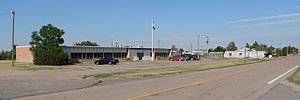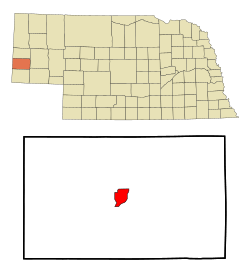Harrisburg, Nebraska facts for kids
Quick facts for kids
Harrisburg, Nebraska
|
|
|---|---|

Downtown with Banner County Courthouse
|
|

Location within Banner County and Nebraska
|
|
| Country | United States |
| State | Nebraska |
| County | Banner |
| Area | |
| • Total | 6.47 sq mi (16.76 km2) |
| • Land | 6.47 sq mi (16.76 km2) |
| • Water | 0.00 sq mi (0.00 km2) |
| Elevation | 4,629 ft (1,411 m) |
| Population
(2020)
|
|
| • Total | 99 |
| • Density | 15.30/sq mi (5.91/km2) |
| Time zone | UTC−7 (Mountain (MST)) |
| • Summer (DST) | UTC−6 (MDT) |
| ZIP code |
69345
|
| Area code(s) | 308 |
| FIPS code | 31-21030 |
| GNIS feature ID | 2393039 |
| Website | Harrisburg |
Harrisburg is a small community in Banner County, Nebraska, United States. It is known as a census-designated place (CDP), which means it's an area identified by the government for statistics, but it's not an officially incorporated town. Harrisburg is also the county seat of Banner County, meaning it's where the county government is located. In 2020, about 99 people lived there.
Contents
Discovering Harrisburg's Past
How Harrisburg Began
Harrisburg and all of Banner County were once part of a larger area called Cheyenne County, Nebraska. The story of Harrisburg began in 1884 when people started to settle the land. These early settlers created "homesteads," which were farms given to them by the government if they promised to live on and improve the land.
A small settlement grew around these homesteads. It was first called Randall, then Centropolis. In November 1888, Cheyenne County was divided into five smaller counties. This new area became Banner County, and the settlement was part of it.
Naming the Town and Moving the County Seat
The first county seat (the main town for county government) was in a place called Ashford, Nebraska, a few miles away. But in 1889, a settler named Charles Schooley gave some of his land to help create a more formal town. A person who had moved from Harrisburg, Pennsylvania suggested the name Harrisburg, and it stuck!
Because Harrisburg was in the middle of the county, it became a hub for stagecoaches and mail carriers. The county government moved its offices from Ashford to Harrisburg in mid-1891.
Harrisburg's Growth and Changes
By 1892, Harrisburg was a busy place. It had two hotels, two places to keep horses (livery stables), a brick factory, a cheese factory, two banks, and three newspapers! It was the most important community in the county. Most people in the area worked in wheat farming and cattle ranching. In 1951, oil was discovered, adding another important product to the county's economy.
Harrisburg's success depended on the county's success. But things changed. The town didn't have a railroad line, which made it hard to ship goods. This caused larger farms to move north. Later, in the 1960s, Interstate Highway 80 was built through Kimball, Nebraska to the south. This made some businesses move there instead.
Other small towns in Banner County disappeared as people moved. Many moved either north or south, or they gathered around Harrisburg. Even with a small number of residents, Harrisburg has continued to thrive into the 21st century.
Exploring Harrisburg's Location
Harrisburg is located in western Nebraska. According to the United States Census Bureau, the entire area of the CDP is about 6.47 square miles (16.76 square kilometers). All of this area is land, with no large bodies of water.
Understanding Harrisburg's Population
| Historical population | |||
|---|---|---|---|
| Census | Pop. | %± | |
| 2020 | 99 | — | |
| U.S. Decennial Census | |||
Harrisburg is part of the Scottsbluff, Nebraska Micropolitan Statistical Area. This means it's connected to the larger Scottsbluff area for economic and social reasons.
The United States Census Bureau tracks information about Harrisburg as a census-designated place (CDP). This helps them understand the population in areas that aren't officially cities or towns.
In the year 2000, there were 75 people living in the Harrisburg CDP. They lived in 31 households, and 23 of these were families. The population was mostly White (about 98.67%). A small percentage (1.33%) were from two or more races. About 2.67% of the population identified as Hispanic or Latino.
The people living in Harrisburg in 2000 included:
- About 21.3% were under 18 years old.
- About 6.7% were between 18 and 24 years old.
- About 14.7% were between 25 and 44 years old.
- About 36.0% were between 45 and 64 years old.
- About 21.3% were 65 years old or older.
The average age of people in Harrisburg in 2000 was 49 years old.
Harrisburg's Climate and Weather
What Kind of Climate Does Harrisburg Have?
Harrisburg has a cold semi-arid climate. This type of climate is often called "BSk" on climate maps. "Semi-arid" means it's quite dry, but not a desert. "Cold" means it has cold winters.
Temperature Records
The hottest temperature ever recorded in Harrisburg was 105°F (41°C). This happened on July 16, 2006, June 24, 2012, and June 27, 2012. The coldest temperature ever recorded was a chilly -44°F (-42°C) on December 22, 1989.
| Climate data for Harrisburg, Nebraska, 1991–2020 normals, extremes 1961–present | |||||||||||||
|---|---|---|---|---|---|---|---|---|---|---|---|---|---|
| Month | Jan | Feb | Mar | Apr | May | Jun | Jul | Aug | Sep | Oct | Nov | Dec | Year |
| Record high °F (°C) | 74 (23) |
78 (26) |
83 (28) |
89 (32) |
97 (36) |
105 (41) |
105 (41) |
103 (39) |
101 (38) |
90 (32) |
81 (27) |
76 (24) |
105 (41) |
| Mean maximum °F (°C) | 61.5 (16.4) |
65.0 (18.3) |
74.8 (23.8) |
80.8 (27.1) |
89.3 (31.8) |
95.8 (35.4) |
99.6 (37.6) |
97.7 (36.5) |
94.1 (34.5) |
85.0 (29.4) |
73.2 (22.9) |
63.2 (17.3) |
100.7 (38.2) |
| Mean daily maximum °F (°C) | 41.2 (5.1) |
43.2 (6.2) |
52.5 (11.4) |
59.5 (15.3) |
68.7 (20.4) |
80.8 (27.1) |
88.4 (31.3) |
86.9 (30.5) |
78.0 (25.6) |
63.3 (17.4) |
51.1 (10.6) |
41.3 (5.2) |
62.9 (17.2) |
| Daily mean °F (°C) | 27.5 (−2.5) |
29.1 (−1.6) |
37.4 (3.0) |
44.2 (6.8) |
54.0 (12.2) |
64.6 (18.1) |
71.8 (22.1) |
69.8 (21.0) |
60.3 (15.7) |
46.7 (8.2) |
35.7 (2.1) |
27.3 (−2.6) |
47.4 (8.5) |
| Mean daily minimum °F (°C) | 13.9 (−10.1) |
14.9 (−9.5) |
22.2 (−5.4) |
29.0 (−1.7) |
39.2 (4.0) |
48.4 (9.1) |
55.2 (12.9) |
52.7 (11.5) |
42.6 (5.9) |
30.0 (−1.1) |
20.4 (−6.4) |
13.4 (−10.3) |
31.8 (−0.1) |
| Mean minimum °F (°C) | −12.7 (−24.8) |
−7.5 (−21.9) |
3.5 (−15.8) |
12.3 (−10.9) |
22.6 (−5.2) |
34.5 (1.4) |
43.5 (6.4) |
40.6 (4.8) |
27.3 (−2.6) |
10.8 (−11.8) |
−2.8 (−19.3) |
−11.2 (−24.0) |
−19.8 (−28.8) |
| Record low °F (°C) | −35 (−37) |
−31 (−35) |
−23 (−31) |
−16 (−27) |
12 (−11) |
26 (−3) |
35 (2) |
32 (0) |
13 (−11) |
−10 (−23) |
−23 (−31) |
−44 (−42) |
−44 (−42) |
| Average precipitation inches (mm) | 0.31 (7.9) |
0.52 (13) |
1.02 (26) |
1.80 (46) |
2.71 (69) |
2.41 (61) |
1.89 (48) |
1.81 (46) |
1.45 (37) |
1.45 (37) |
0.66 (17) |
0.49 (12) |
16.52 (419.9) |
| Average snowfall inches (cm) | 5.5 (14) |
8.2 (21) |
7.1 (18) |
6.0 (15) |
1.6 (4.1) |
0.0 (0.0) |
0.0 (0.0) |
0.0 (0.0) |
0.6 (1.5) |
4.2 (11) |
5.0 (13) |
8.4 (21) |
46.6 (118.6) |
| Average extreme snow depth inches (cm) | 4.7 (12) |
4.6 (12) |
4.3 (11) |
3.4 (8.6) |
1.3 (3.3) |
0.0 (0.0) |
0.0 (0.0) |
0.0 (0.0) |
0.3 (0.76) |
2.8 (7.1) |
3.8 (9.7) |
5.8 (15) |
9.5 (24) |
| Average precipitation days (≥ 0.01 in) | 4.1 | 5.3 | 5.6 | 8.7 | 10.4 | 9.2 | 7.4 | 6.6 | 5.7 | 6.4 | 4.2 | 4.6 | 78.2 |
| Average snowy days (≥ 0.1 in) | 3.8 | 5.5 | 3.8 | 2.4 | 0.7 | 0.0 | 0.0 | 0.0 | 0.2 | 1.4 | 2.9 | 4.5 | 25.2 |
| Source 1: NOAA | |||||||||||||
| Source 2: National Weather Service | |||||||||||||
See also
 In Spanish: Harrisburg (Nebraska) para niños
In Spanish: Harrisburg (Nebraska) para niños

